Mission Operations
Day to Day Operations
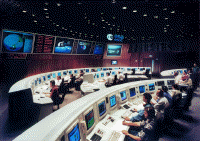 |
|
The main control room for Cluster at ESOC, in Darmstadt, Germany |
One of the most challenging aspects of Cluster is the launch and control of four identical spacecraft. The day-to-day operation of the spacecraft is carried out by the European Space Operations Centre (ESOC) in Darmstadt, Germany. The main control room at ESOC was used during the launch and early orbit phases of the mission, with teams of operators working around the clock. About two weeks after the second Cluster launch, mission operations was switched to a smaller, dedicated control room.
ESOC is responsible for:
- transfer of the four satellites into their operational orbits and their correct orbital positions
- combined operation of the four spacecraft and their payloads
- collection and distrubution to the scientific community of all the raw science data, as well as monitoring of spacecraft health, orbits etc.
Spacecraft telemetry, command and tracking are handled primarily by the ESA ground station in Villafranca, Spain, with supplementary support from NASA's Deep Space Network. In the critical early stages between launch and final orbit insertion, additional ground stations in Kourou (French Guiana), Perth (Australia) and Kiruna (Sweden) were used.
During the two-year mission, signals to and from the spacecraft are routed through the Operations Control Centre at ESOC. The centre controls the spacecraft and their payloads, and carries out all activities related to mission planning and scheduling. Normal ESOC operations are interrupted every six months to conduct orbit manoeuvres. Controllers adjust the separation distances between the four spacecraft in order to allow the study of different scientific phenomena.
One of the main factors influencing data acquisition and spacecraft control is the limited time available for ground contact with the spacecraft. On average they are visible for about 10 hours per day from the Villafranca ground station. However, since there are four Cluster spacecraft, the time available to acquire data from each one is only around two and a half hours per day.
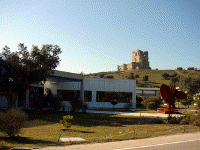 |
|
The ESA ground station in Villafranca, Spain |
The Joint Science Operations Centre (JSOC) at Rutherford Appleton Laboratory in the UK co-ordinates the science operations. Its main task is to merge all commands coming from the 11 instrument teams into an overall command schedule, which is then be sent through ESOC to the 44 spacecraft instruments. JSOC also collects and processes the data needed to plan these instrument operations and monitors the performance of the individual instruments.
The vast amount of scientific information sent back by the four spacecraft is handled by the Cluster Science Data System (CSDS). This comprises eight national data centres - six in Europe, one in the USA and one in China. The CSDS supports scientific data processing and distribution activities. Raw data from the spacecraft is distributed on CD-ROM to scientists around the world.
Communications & Tracking
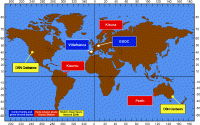 |
|
Map of Cluster Ground Station Network |
Spacecraft telemetry, command and tracking is carried out primarily by the ESA ground station in Villafranca, Spain, with support from NASA's Deep Space Network. In the critical early stages between launch and final orbit insertion, additional ground stations in Kourou (French Guiana), Perth (Australia) and Kiruna (Sweden) were used.
The ESA Ground Stations and Communications Network (ESTRACK) performs the telemetry, command and tracking operations in the S-band radio frequencies via the Villafranca ground station. Wide band data acquisition is also possible via the NASA Deep Space Network ground stations in California, Spain and Australia.
The Villafranca ground station
ESA's Villafranca del Castillo Satellite Tracking Station (VILSPA), which is located in Villanueva de la Caqada (some 28 km northwest of Madrid), is the prime Telemetry, Tracking and Command (TT&C) station for Cluster.
The antenna used is an S-band, 15 metre dish (VIL-1) which was formerly used for the International Ultraviolet Explorer (IUE) mission from 1976 to 1996 and for the Infrared Space Observatory (ISO) mission from 1996 to 1998. VIL-1 was refurbished and upgraded to meet the requirements of the Cluster mission, using many parts from the Odenwald antenna in Germany, which was originally to be used for the first Cluster spacecraft.
Since IUE and ISO were slow-moving satellites, the antenna servo speed and tracking receiver response were not considered to be of major importance. However, the Cluster satellites have highly elliptical orbits and require high velocity tracking, so the modifications to the VIL-1 antenna included replacement of the old servo and tracking systems.
The Cluster antenna at Villafranca
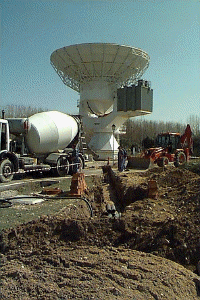 |
|
Cluster antenna at Villafranca during upgrading |
A major upgrade of the antenna started on 19 November 1998 with the arrival at Villafranca of 26 boxes, transported by truck from Odenwald (Germany). They contained antenna dish panels, cable twister, feed horn, servo gearboxes and electronic equipment weighing more than 23 tonnes.
The Antenna Equipment Room (AER) cabin and the subreflector arrived by a special 3.2 metre wide transport. Special permission for this transfer was required from authorities of Germany, France and Spain. During the entire journey, which lasted more than two weeks, the cabin heating and dehydrator systems had to be powered up to avoid condensation on the equipment and waveguides.
The VIL-1 upgrade featured replacement of the following:
- the dish panels (60 panels divided in 5 sectors, located in 3 rings)
- the subreflector
- the feedhorn and mirror
- the gearboxes (modified in order to increase the antenna velocity to 3 degrees per second)
- the cable twister
- the AER cabin and related equipment
- the dehydrator system
In April 1999, ground station telemetry, telecommand, ranging and communications equipment arrived from the ex-Odenwald antenna. The VIL-1 upgrade activities were completed in autumn 1999 and supported the ground system validation prior to launch.
Structures
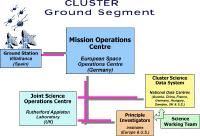 |
|
Diagram of Cluster operations |
- an Operations Control Centre (OCC)
- ESA's Ground Stations and Communications Network (ESTRACK)
- the Cluster Science Data System (CSDS)
Operations Control Centre
The core of the Operations Control Centre (OCC) facilities is the Cluster Mission Control System. This handles:
- real-time/near real-time data-processing tasks essential for controlling the mission
- acquisition and interim storage of raw scientific data
- payload command requests, together with the planning and scheduling of satellite operations
The Mission Control System is supplemented by the Flight Dynamics System, which handles all satellite activities related to orbit, attitude determination and control.
The Cluster communications networks plays a vital part in the mission. Information is relayed between team members by means of the public internet and via ISDN lines which are leased from national telecommunications companies.
In this way, the Cluster team is able to retrieve raw science, 'housekeeping' and auxiliary data stored at the OCC; to submit requests (via the Joint Science Operations Centre in the UK) to the OCC for commands to be sent to the spacecraft; and to electronically exchange processed science data and related software between the national data centres.
